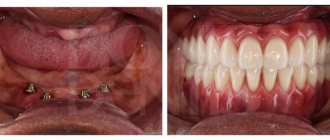| Appointment with a surgeon in Moscow on the same day of treatment | Reception is strictly by appointment, make an appointment by phone: +7 | Prices for services | Reviews about the clinic |
Abscess on the lip
- this is the formation of a purulent process that develops as a result of the penetration of pathogenic pathogens into the tissues of a given area. The starting mechanism for the formation of an abscess is trauma to the mucous membrane of the lips from the oral cavity or damage to the skin on the face. Another reason for the formation of deep abscesses is multiple pustular rashes on the face.
An abscess on the lip is an extremely dangerous condition, since the likelihood of its spreading throughout the cellular spaces is extremely high. Due to the intensive blood supply to the face, the spread of the purulent process to the infraorbital and buccal area occurs extremely quickly.
Make an appointment with a surgeon by phone or by filling out the online form
| Select a clinic | Abdominal ultrasound | Gastroenterologist | Calling a surgeon to your home |
Useful information on the topic:
- Abscess
- Abscess on the stomach
- Abscess of the buttocks
- Opening an abscess
- Abscess treatment
- Causes of abscess
Causes and mechanisms
Any changes in the skin and mucous membranes have their source. If a sore appears on your lip, then first of all it is worth understanding its origin, because all further measures depend on this. But high-quality diagnostics without a doctor is impossible in principle.
There are quite a lot of diseases that occur with damage to the lips. In the practice of a dermatologist or dentist, one most often encounters the following pathology:
- Aphthous stomatitis.
- Herpetic infection.
- Candidiasis (thrush).
- Pustular diseases (pyoderma).
These conditions are of inflammatory origin and are caused by microbial aggression. But there are also diseases with other development mechanisms. Blistering dermatoses, for example, are associated with hypersensitivity reactions and autoimmune processes, and leukoplakia occurs due to transformation of the epithelium under the influence of external factors.
Of course, the list of probable pathologies is far from complete. It has a place for general infections, toxic-allergic and congenital dermatoses, immunodeficiency states and vitamin deficiencies, and traumatic injuries. And each of the presented conditions is accompanied by changes in the lips.
Changes in the lips (external or internal) are of multifactorial origin, accompanying the development of many diseases.
When to contact a specialist
First, you should evaluate the condition of the lip and oral cavity. If the injury is minor, the abscess is small, the lesion is single, and there are no accompanying symptoms, you can try to cope with the problem on your own. It is necessary to treat the damaged area with an antiseptic. Under no circumstances should you try to squeeze out the pus yourself. A doctor's help is needed in the following cases:
- if the size of the abscess is large, this area is painful, severe swelling is visible. The area may need to be opened surgically;
- change in color of the mucous membrane, severe swelling;
- throbbing pain;
- hyperthermia;
- discharge of various shades;
- weakness.
Even if there is a slight inflammatory process, consulting a doctor will not be superfluous.
Why does the ulcer not heal for a long time?
The activity of regenerative processes depends on many factors. When you have to deal with slow healing of mucocutaneous damage - erosions, ulcers, cracks - you have to look for the source of the problem. Local impact factors include:
- Cleansing components of toothpastes.
- Reaction to denture and crown materials.
- Exposure to food (rough, spicy, hot).
- Secondary microbial flora (caries, tonsillitis).
- Habitual biting of the mucous membrane.
Considering the general prerequisites for the protracted course of the disease, it is worth paying special attention to concomitant pathology associated with a violation of the protective properties of the epithelium, metabolism and blood circulation. Among these conditions are:
- Diabetes.
- Chronic infections.
- Autoimmune diseases.
- Severe somatic pathology.
- Oncological processes.
- Anemia and leukemia.
In addition, slow healing of injuries is typical for elderly patients and occurs with physical exhaustion and poor nutrition. Hypothermia, prolonged stress, and hormonal changes in the body also have a negative impact on the body's resistance.
Long-term healing of lesions on the lips is a consequence of weakening the mechanisms of local and general resistance of the body.
Why do sores form?
An ugly and painful abscess that appears suddenly and seemingly out of nowhere is a fairly common occurrence. Any neoplasm on the body, mucous membranes or inside the body requires a medical examination so as not to aggravate the malaise with further complications.
Only a doctor can reliably determine the reason for the ulcers. They can be located in any part of the oral cavity; white, bloody bumps in the lip area are often observed.
Research has shown the following reasons for their occurrence:
- the mucous membrane is damaged with the formation of microcracks, a favorable place for the development of microbes that cause inflammatory processes
- a consequence of colds, weakening of the immune system, leaving viruses in the form of herpes
- trauma to the mouth from thermal and chemical substances
- from being in the wind, drafts
- allergy or trigger of another disease
- insufficient hygiene care
Each unfavorable manifestation is different in its appearance, has a certain classification of infectious origin, but these inflamed skin, abscessing mucous membranes are united - the treatment has its own identity. The effectiveness of the procedures performed depends on the severity of the infection.
How does the disease manifest itself?
When the pathological process is accompanied by damage to the tissue of the lips on the outside (skin, red border) and is inflammatory in nature, it is called cheilitis. This is the most common situation that can be addressed to a dermatologist. Damage to the mucous membrane can also be classified as stomatitis, especially if other areas of the oral cavity are also affected.
Aphthous stomatitis
Very often in a doctor’s practice one has to deal with stomatitis, in which erosions form on the mucous membrane, covered with a gray fibrinous coating - aphthae. First, a small focus forms - a red spot on the inside of the lips or a transitional fold, but soon typical defects form, spreading to the lateral surfaces of the tongue. Stomatitis is also accompanied by subjective symptoms:
- Burning.
- Soreness.
- Salivation.
- Difficulty eating and speaking.
In the necrotic form of stomatitis, the previously formed aphthae deepen, transforming into ulcers. A distinctive feature is that the defects are characterized by mild pain. Their epithelization can take up to a month.
Herpetic infection
The prevalence of herpes infection is very wide - the majority of the population is infected with the corresponding viruses. The lip area is a favorite location for herpes simplex (labial). When small bubbles pop up there, this is what they often mean. An exacerbation of herpetic infection is usually observed after hypothermia, acute respiratory viral infection, or during menstruation in girls.
Before the appearance of vesicles, a burning sensation and itching is felt, redness and slight swelling occur. After some time, raised elements form on the lip - vesicles filled with serous contents. Very quickly their tire bursts with the formation of weeping erosion. Damage heals with the formation of crusts, leaving no traces behind.
Many people have probably experienced the signs of a herpes infection. Blisters on the lips are its typical manifestation.
Candidiasis
Having noticed a white coating on the inside of the lips, one cannot help but think about such a common condition as thrush. Yeast-like bacteria from the genus Candida are opportunistic microbes, but when the protective properties of the mucous membrane decrease, they multiply there and provoke inflammation.
Why pus may appear on the lip and what it means
A furuncle on the lip (boil) is a purulent-necrotic inflammation of the sebaceous gland, hair follicle and the connective tissue surrounding them outside. It occurs due to infection with staphylococcus and is quite dangerous if left untreated. Pus on the lip often appears in people with an unbalanced diet and weak immunity.
Causes of external ulcers:
How to smear a child's abscess?
External treatment of pyoderma in childhood does not differ from what has already been described. You can anoint a child’s abscess with any antiseptic, except, perhaps, boric alcohol. And in case of widespread damage, it is worth considering the likelihood of systemic absorption of any drugs through the more delicate and thinner skin of children.
For streptococcal impetigo, first soften the crust with hydrogen peroxide, and then apply antibacterial ointment. Healthy skin around is lubricated with salicylic alcohol. An abscess on the mucous membrane is treated with the same water-oil-based preparations.
The use of antiviral drugs orally is not required, unless we are talking about a primary infection or a complicated course of the infection.
Provoking factors
Boils in all parts of the body occur for the same reasons, which include:
- Using expired cosmetics.
- Failure to comply with personal hygiene rules.
- Damage to the skin.
- Using toothpaste that corrodes the skin of the lips.
- Herpes that was not treated correctly.
In addition to the listed provoking factors, there are other reasons why Staphylococcus aureus multiplies rapidly. The abscess can grow rapidly due to excessive sweating, the habit of going to bed with cosmetics on the face and poor quality of skin cleansing.
A boil can develop if the sebaceous glands become clogged with dust. First, a black dot forms on the body, which over time will turn into a white pimple. It is important to remember that a boil is a painful neoplasm, which is why it is necessary to fight this disease immediately after identifying the first signs of inflammation on the skin.
The following symptoms are common:
Types of rashes on the lips
Rashes in the area of both the mouth and lips can be different. They differ in their appearance, reasons for formation, and degree of danger. They may appear on the skin and mucous membranes.
Some types of rashes that affect these areas create discomfort and spoil the appearance, but do not pose a threat to health. Other varieties are a sign of disturbances in the functioning of the body, and therefore require identification of the causes and prompt treatment.
But before carrying out therapy, you need to find out the type of pathology.
The following types of such formations can be distinguished:
- Herpes. Herpes rashes can affect the area around the mouth, lips and oral mucosa. They look like small bubbles, which can be either single or multiple. Inside them there is initially a clear liquid, which becomes cloudy after a few days. Next, the bubbles burst and form a crust on the lips. This disease is accompanied by itching, burning, and swelling of the affected areas.
- Candidiasis . The disease occurs due to a yeast fungus that is constantly present in the human microflora. In the presence of favorable factors, the fungus actively multiplies, affecting different areas of the skin and mucous membranes. When it develops, a white coating forms in the mouth area inside the mouth and on the lips.
- Afty . Their formation is caused by the action of bacteria. At the first stage of their development, an abscess is formed. Subsequently, it deforms when it transforms into a circle with bloody borders and a white dot in the middle. The patient's temperature rises, the sensitivity of the damaged area increases, and the gums may bleed.
- Allergy . It often manifests itself as rashes of various types. They are caused by allergenic substances (medicines, food, etc.). Along with the formation of ulcers, other problems also appear - swelling of the affected surface, inflammation, pain. When ulcers rupture, erosions can form.
- Traumatic ulcers . Such abscesses are the result of careless actions - burns and mechanical damage to this area. They are formed as a result of bacteria entering the wound, causing an inflammatory process, which results in the formation of an abscess. To eliminate it safely, it is very important to contact a specialist.
- Stomatitis . This is a disease of the oral cavity in which ulcers form on the mucous membrane of the mouth. They look like small bubbles with a sharp top. They cause pain, and when large, they create significant discomfort. The damaged surface often swells.
It is quite difficult to distinguish one type of ulcer from another on your own. Therefore, it is recommended to consult a doctor even if the formation does not seem dangerous and does not cause serious problems. Sometimes a harmless symptom may be the only sign of a dangerous pathology that requires careful treatment.
Knowing the types of purulent formations in and near the mouth is important in order to understand what is happening in the body. But it is much more important to understand what the causes of their occurrence are, since the principle of treatment depends on them.
Treatment
Therapeutic tactics are determined by the nature of the pathology identified during the examination. Only a doctor can make a diagnosis and determine which methods will be the most effective to solve the problem. In addition to specific correction, general measures also play a significant role:
- Mechanically, thermally and chemically gentle food (ground, without spicy food, at a comfortable temperature).
- Avoiding contact with allergens.
- Quitting alcohol and smoking.
- Compliance with personal hygiene rules.
- Careful oral care.
- Removal of dissimilar metals in prostheses, their processing, etc.
To increase the body's resistance, it is recommended to take multivitamins, eat well and lead a healthy lifestyle. It is also necessary to promptly treat concomitant pathologies that have a negative impact on immune reactivity.
How to treat an ulcer?
Erosion and ulcers require elimination of the causative factor (primarily infectious), cleansing of defects, acceleration of healing processes and alleviation of symptoms. The following medications are used for this:
- Antiseptics (hydrogen peroxide, furatsilin, chlorhexidine, citral).
- Local anesthetics (anesthesin, lidocaine, novocaine).
- Proteolytic enzymes (trypsin, chymotrypsin).
- Corticosteroids (hydrocortisone).
- Reparants (Solcoseryl, Actovegin).
- Vitamins (retinol, tocopherol).
In addition to external drugs, antihistamines (Tavegil, Zyrtek, Suprastin), antibacterials (metronidazole, penicillins), immunomodulators, and sedatives are used in treatment. Physiotherapy in the form of electro- and phonophoresis and laser therapy are combined with drug correction.
Ulcerative defects and erosions of the mucous membrane require active and comprehensive correction under the guidance of a physician.
How to get rid of an abscess?
Superficial pyoderma can only be treated with external means. For this purpose, the lesions are treated with various antiseptics:
- Diamond green.
- Boric alcohol.
- Fukortsin.
They treat both a ripening abscess on the skin and an opened one. But alcohol solutions are not used to treat mucous membranes - water- or oil-based preparations (chlorophyllipt, chlorhexidine, furatsilin) are needed. After the pus has drained, the elements are treated with antibacterial ointments (erythromycin, lincomycin) and liniments (chloramphenicol, synthomycin).
Common forms of pyoderma require systemic antibacterial therapy with penicillins (Ampiox, Augmentin), macrolides (Sumamed), cephalosporins (Klaforan, Cefobid), fluoroquinolones (Tsiprolet). Therapy regimens also contain drugs that increase immunity to bacterial pathogens - staphylococcal plasma, bacteriophage, toxoid, vaccine, gamma globulin.
How to deal with the problem
It is important to start treatment as early as possible. When caring for children, you should not try to cope with the problem on your own. It is best to contact a specialist who will select the right treatment. Depending on the underlying cause, a treatment regimen is selected.
If the cause of the abscess is a bacterial infection, antibacterial drugs are prescribed: amoxicillin, amoxiclav, cefuroxime.
If the problem is of fungal origin, antifungal agents are used - nystatin.
Herpes in such an advanced form is treated with oral antiherpetic drugs - acyclovir, herpevir. The dosage of the drugs is selected by the doctor.
Local processing is carried out using:
- a weeping wound is treated with antiseptics - miramistin, chlorhexidine, furatsilin, hydrogen peroxide;
- streptocid ointment;
- Vishnevsky ointment;
- metrogyla;
- gentamicin ointment;
- salicylic ointment;
- ointment Rescuer;
- levomekol.
To speed up healing after opening an abscess, use:
- sea buckthorn oil;
- rosehip oil;
- solcoseryl;
- panthenol.
Additionally, you can use folk remedies: a decoction of chamomile, calendula, string. sage, green tea compresses. Such remedies reduce itching and soreness, and help relieve the inflammatory process.



